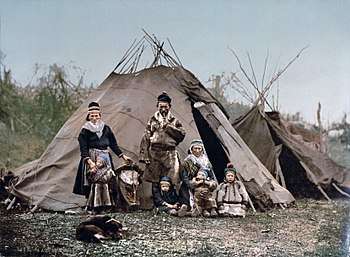Nomad
A nomad (Middle French: nomade "people without fixed habitation")[1] is a member of a community without fixed habitation which regularly moves to and from the same areas. Such groups include hunter-gatherers, pastoral nomads (owning livestock), and tinkers or trader nomads.[2][3] In the twentieth century, population of nomadic pastoral tribes slowly decreased, reaching to an estimated 30–40 million nomads in the world as of 1995.[4][5]
| Part of a series on |
| Economic, applied, and development anthropology |
|---|
|
Provisioning systems |
|
Case studies
|
| Social and cultural anthropology |
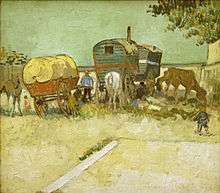
| Look up nomad in Wiktionary, the free dictionary. |
Nomadic hunting and gathering—following seasonally available wild plants and game—is by far the oldest human subsistence method.[6] Pastoralists raise herds, driving or accompanying in patterns that normally avoid depleting pastures beyond their ability to recover.[7]
Nomadism is also a lifestyle adapted to infertile regions such as steppe, tundra, or ice and sand, where mobility is the most efficient strategy for exploiting scarce resources. For example, many groups living in the tundra are reindeer herders and are semi-nomadic, following forage for their animals.
Sometimes also described as "nomadic" are the various itinerant populations who move among densely populated areas to offer specialized services (crafts or trades) to their residents—external consultants, for example. These groups are known as "peripatetic nomads".[8][9]
Common characteristics
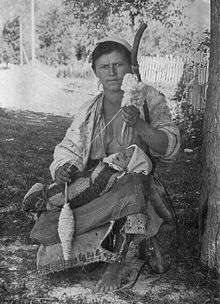
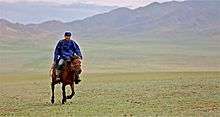
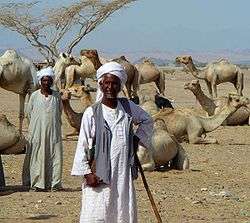
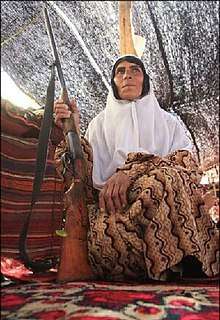
A nomad is a person with no settled home, moving from place to place as a way of obtaining food, finding pasture for livestock, or otherwise making a living. The word "nomad" comes ultimately from the classical Greek word νομάς (nomás, "roaming, wandering, especially to find pasture"), from Ancient Greek νομός (nomós, "pasture"). Most nomadic groups follow a fixed annual or seasonal pattern of movements and settlements. Nomadic peoples traditionally travel by animal or canoe or on foot. Today, some nomads travel by motor vehicle. Most nomads live in tents or other portable shelters.
Nomads keep moving for different reasons. Nomadic foragers move in search of game, edible plants, and water. Aboriginal Australians, Negritos of Southeast Asia, and San of Africa, for example, traditionally move from camp to camp to hunt and gather wild plants. Some tribes of the Americas followed this way of life. Pastoral nomads make their living raising livestock such as camels, cattle, goats, horses, sheep or yaks; the Gaddi tribe of Himachal Pradesh in India is one such tribe. These nomads travel to find more camels, goats and sheep through the deserts of Arabia and northern Africa. The Fulani and their cattle travel through the grasslands of Niger in western Africa. Some nomadic peoples, especially herders, may also move to raid settled communities or to avoid enemies. Nomadic craftworkers and merchants travel to find and serve customers. They include the Lohar blacksmiths of India, the Romani traders, Scottish travellers, Irish travellers.
Most nomads travel in groups of families, bands or tribes. These groups are based on kinship and marriage ties or on formal agreements of cooperation. A council of adult males makes most of the decisions, though some tribes have chiefs.
In the case of Mongolian nomads, a family moves twice a year. These two movements generally occur during the summer and winter. The winter destination is usually located near mountains in a valley and most families already have fixed winter locations. Their winter locations have shelter for animals and are not used by other families while they are out. In the summer they move to a more open area that the animals can graze. Most nomads usually move in the same region and don't travel very far to a totally different region. Since they usually circle around a large area, communities form and families generally know where the other ones are. Often, families do not have the resources to move from one province to another unless they are moving out of the area permanently. A family can move on its own or with others; if it moves alone, they are usually no more than a couple of kilometers from each other. Nowadays there are no tribes and decisions are made among family members, although elders consult with each other on usual matters. The geographical closeness of families is usually for mutual support. Pastoral nomad societies usually do not have large population. One such society, the Mongols, gave rise to the largest land empire in history. The Mongols originally consisted of loosely organized nomadic tribes in Mongolia, Manchuria, and Siberia. In the late 12th century, Genghis Khan united them and other nomadic tribes to found the Mongol Empire, which eventually stretched the length of Asia.
The nomadic way of life has become increasingly rare. Many countries have converted pastures into cropland and forced nomadic peoples into permanent settlements.
Although (or because) "[t]he sedentary man envies the nomadic existence, the heck for green pastures [...]"[10] sedentarist prejudice against nomads, "shiftless" "gypsies", "rootless cosmopolitans", "primitive" hunter-gatherers, refugees and urban homeless street-people persists.
Hunter-gatherers
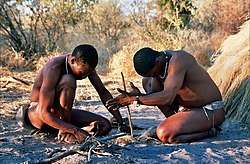
Nomads (also known as foragers) move from campsite to campsite, following game and wild fruits and vegetables. Hunting and gathering describes early people's subsistence living style. Following the development of agriculture, most hunter-gatherers were eventually either displaced or converted to farming or pastoralist groups. Only a few contemporary societies are classified as hunter-gatherers; and some of these supplement, sometimes extensively, their foraging activity with farming or keeping animals.
Pastoralism

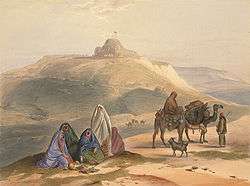
Pastoral nomads are nomads moving between pastures. Nomadic pastoralism is thought to have developed in three stages that accompanied population growth and an increase in the complexity of social organization. Karim Sadr has proposed the following stages:[12]
- Pastoralism: This is a mixed economy with a symbiosis within the family.
- Agropastoralism: This is when symbiosis is between segments or clans within an ethnic group.
- True Nomadism: This is when symbiosis is at the regional level, generally between specialised nomadic and agricultural populations.
The pastoralists are sedentary to a certain area, as they move between the permanent spring, summer, autumn and winter (or dry and wet season) pastures for their livestock. The nomads moved depending on the availability of resources.[13]
Origin
Nomadic pastoralism seems to have developed as a part of the secondary products revolution proposed by Andrew Sherratt, in which early pre-pottery Neolithic cultures that had used animals as live meat ("on the hoof") also began using animals for their secondary products, for example, milk and its associated dairy products, wool and other animal hair, hides and consequently leather, manure for fuel and fertilizer, and traction.
The first nomadic pastoral society developed in the period from 8,500–6,500 BCE in the area of the southern Levant.[14] There, during a period of increasing aridity, Pre-Pottery Neolithic B (PPNB) cultures in the Sinai were replaced by a nomadic, pastoral pottery-using culture, which seems to have been a cultural fusion between a newly arrived Mesolithic people from Egypt (the Harifian culture), adopting their nomadic hunting lifestyle to the raising of stock.[15]
This lifestyle quickly developed into what Jaris Yurins has called the circum-Arabian nomadic pastoral techno-complex and is possibly associated with the appearance of Semitic languages in the region of the Ancient Near East. The rapid spread of such nomadic pastoralism was typical of such later developments as of the Yamnaya culture of the horse and cattle nomads of the Eurasian steppe, or of the Mongol spread of the later Middle Ages.[15]
Trekboer in southern Africa adopted nomadism from the 17th century.[16]
Increase in post-Soviet Central Asia
One of the results of the break-up of the Soviet Union and the subsequent political independence and economic collapse of its Central Asian republics has been the resurgence of pastoral nomadism.[17] Taking the Kyrgyz people as a representative example, nomadism was the centre of their economy before Russian colonization at the turn of the 20th century, when they were settled into agricultural villages. The population became increasingly urbanized after World War II, but some people still take their herds of horses and cows to high pastures (jailoo) every summer, continuing a pattern of transhumance.
Since the 1990s, as the cash economy shrank, unemployed relatives were reabsorbed into family farms, and the importance of this form of nomadism has increased. The symbols of nomadism, specifically the crown of the grey felt tent known as the yurt, appears on the national flag, emphasizing the central importance of nomadism in the genesis of the modern nation of Kyrgyzstan.[18]
Sedentarization
From 1920 to 2008, population of nomadic pastoral tribes slowly decreased from over a quarter of Iran's population.[4][19] Tribal pastures were nationalized during the 1960s. The National Commission of UNESCO registered the population of Iran at 21 million in 1963, of whom two million (9.5%) were nomads.[20] Although the nomadic population of Iran has dramatically decreased in the 20th century, Iran still has one of the largest nomadic populations in the world, an estimated 1.5 million in a country of about 70 million.[21]
In Kazakhstan where the major agricultural activity was nomadic herding,[22] forced collectivization under Joseph Stalin's rule met with massive resistance and major losses and confiscation of livestock.[23] Livestock in Kazakhstan fell from 7 million cattle to 1.6 million and from 22 million sheep to 1.7 million. The resulting famine of 1931–1934 caused some 1.5 million deaths: this represents more than 4.0% of the total Kazakh population at that time.[24]
In the 1950s as well as the 1960s, large numbers of Bedouin throughout the Middle East started to leave the traditional, nomadic life to settle in the cities of the Middle East, especially as home ranges have shrunk and population levels have grown. Government policies in Egypt and Israel, oil production in Libya and the Persian Gulf, as well as a desire for improved standards of living, effectively led most Bedouin to become settled citizens of various nations, rather than stateless nomadic herders. A century ago nomadic Bedouin still made up some 10% of the total Arab population. Today they account for some 1% of the total.[25]
At independence in 1960, Mauritania was essentially a nomadic society. The great Sahel droughts of the early 1970s caused massive problems in a country where 85% of its inhabitants were nomadic herders. Today only 15% remain nomads.[26]
As many as 2 million nomadic Kuchis wandered over Afghanistan in the years before the Soviet invasion, and most experts agreed that by 2000 the number had fallen dramatically, perhaps by half. The severe drought had destroyed 80% of the livestock in some areas.[27]
Niger experienced a serious food crisis in 2005 following erratic rainfall and desert locust invasions. Nomads such as the Tuareg and Fulani, who make up about 20% of Niger's 12.9 million population, had been so badly hit by the Niger food crisis that their already fragile way of life is at risk.[28] Nomads in Mali were also affected.[29]
Lifestyle

Pala nomads living in Western Tibet have a diet that is unusual in that they consume very few vegetables and no fruit. The main staple of their diet is tsampa and they drink Tibetan style butter tea. Pala will eat heartier foods in the winter months to help keep warm. Some of the customary restrictions they explain as cultural saying only that drokha do not eat certain foods, even some that may be naturally abundant. Though they live near sources of fish and fowl these do not play a significant role in their diet, and they do not eat carnivorous animals, rabbits or the wild asses that are abundant in the environs, classifying the latter as horse due to their cloven hooves. Some families do not eat until after the morning milking, while others may have a light meal with butter tea and tsampa. In the afternoon, after the morning milking, the families gather and share a communal meal of tea, tsampa and sometimes yogurt. During winter months the meal is more substantial and includes meat. Herders will eat before leaving the camp and most do not eat again until they return to camp for the evening meal. The typical evening meal may include thin stew with tsampa, animal fat and dried radish. Winter stew would include a lot of meat with either tsampa or boiled flour dumplings.[30]
Nomadic diets in Kazakhstan have not changed much over centuries. The Kazakh nomad cuisine is simple and includes meat, salads, marinated vegetables and fried and baked breads. Tea is served in bowls, possibly with sugar or milk. Milk and other dairy products, like cheese and yogurt, are especially important. Kumiss is a drink of fermented milk. Wrestling is a popular sport, but the nomadic people do not have much time for leisure. Horse riding is a valued skill in their culture.[31]
Contemporary peripatetic minorities in Europe and Asia
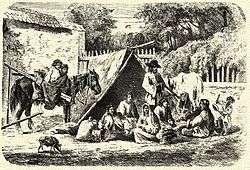
Peripatetic minorities are mobile populations moving among settled populations offering a craft or trade.[32]
Each existing community is primarily endogamous, and subsists traditionally on a variety of commercial or service activities. Formerly, all or a majority of their members were itinerant, and this largely holds true today. Migration generally takes place within the political boundaries of a single state these days.
Each of the peripatetic communities is multilingual, it speaks one or more of the languages spoken by the local sedentary populations, and, additionally, within each group, a separate dialect or language is spoken. They are speaking languages of Indic origin and many are structured somewhat like an argot or secret language, with vocabularies drawn from various languages. There are indications that in northern Iran at least one community speaks Romani language, and some groups in Turkey also speak Romani.
Dom people
In Afghanistan, the Nausar worked as tinkers and animal dealers. Ghorbat men mainly made sieves, drums, and bird cages, and the women peddled these as well as other items of household and personal use; they also worked as moneylenders to rural women. Peddling and the sale of various goods was also practiced by men and women of various groups, such as the Jalali, the Pikraj, the Shadibaz, the Noristani, and the Vangawala. The latter and the Pikraj also worked as animal dealers. Some men among the Shadibaz and the Vangawala entertained as monkey or bear handlers and snake charmers; men and women among the Baluch were musicians and dancers. The Baluch men were warriors that were feared by neighboring tribes and often were used as mercenaries. Jogi men and women had diverse subsistence activities, such as dealing in horses, harvesting, fortune-telling, bloodletting, and begging.
In Iran the Asheq of Azerbaijan, the Challi of Baluchistan, the Luti of Kurdistan, Kermānshāh, Īlām, and Lorestān, the Mehtar in the Mamasani district, the Sazandeh of Band-i Amir and Marv-dasht, and the Toshmal among the Bakhtyari pastoral groups worked as professional musicians. The men among the Kowli worked as tinkers, smiths, musicians, and monkey and bear handlers; they also made baskets, sieves, and brooms and dealt in donkeys. Their women made a living from peddling, begging, and fortune-telling.
The Ghorbat among the Basseri were smiths and tinkers, traded in pack animals, and made sieves, reed mats, and small wooden implements. In the Fārs region, the Qarbalband, the Kuli, and Luli were reported to work as smiths and to make baskets and sieves; they also dealt in pack animals, and their women peddled various goods among pastoral nomads. In the same region, the Changi and Luti were musicians and balladeers, and their children learned these professions from the age of 7 or 8 years.
The nomadic groups in Turkey make and sell cradles, deal in animals, and play music. The men of the sedentary groups work in towns as scavengers and hangmen; elsewhere they are fishermen, smiths, basket makers, and singers; their women dance at feasts and tell fortunes. Abdal men played music and made sieves, brooms, and wooden spoons for a living. The Tahtacı traditionally worked as lumberers; with increased sedentarization, however, they have taken to agriculture and horticulture.
Little is known for certain about the past of these communities; the history of each is almost entirely contained in their oral traditions. Although some groups—such as the Vangawala—are of Indian origin, some—like the Noristani—are most probably of local origin; still others probably migrated from adjoining areas. The Ghorbat and the Shadibaz claim to have originally come from Iran and Multan, respectively, and Tahtacı traditional accounts mention either Baghdad or Khorāsān as their original home. The Baluch say they were attached as a service community to the Jamshedi, after they fled Baluchistan because of feuds.[33][34]
Kochi people
Romani people
Yörüks
Yörüks are the nomadic people who live in Turkey. Still some groups such as Sarıkeçililer continues nomadic lifestyle between coastal towns Mediterranean and Taurus Mountains even though most of them were settled by both late Ottoman and Turkish republic.
Image gallery
_(14592471478).jpg) Mongol nomads in the Altai Mountains.
Mongol nomads in the Altai Mountains..jpg) Snake charmer from Telungu community of Sri Lanka.
Snake charmer from Telungu community of Sri Lanka.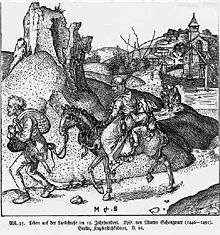 Yeniche people in the 15th century
Yeniche people in the 15th century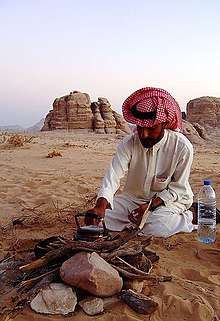
 Kyrgyz nomads in the steppes of the Russian Empire, Uzbekistan, by pioneer color photographer Sergey Prokudin-Gorsky, c. 1910.
Kyrgyz nomads in the steppes of the Russian Empire, Uzbekistan, by pioneer color photographer Sergey Prokudin-Gorsky, c. 1910. Tuareg in Mali, 1974.
Tuareg in Mali, 1974. Kyrgyz nomads, 1869–1870.
Kyrgyz nomads, 1869–1870.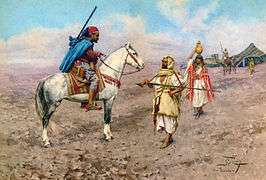 Nomads in the Desert (Giulio Rosati).
Nomads in the Desert (Giulio Rosati). Gros Ventre (Atsina) American Indians moving camps with travois for transporting skin lodges and belongings.
Gros Ventre (Atsina) American Indians moving camps with travois for transporting skin lodges and belongings. House barge of the Sama-Bajau peoples, Indonesia. 1914–1921
House barge of the Sama-Bajau peoples, Indonesia. 1914–1921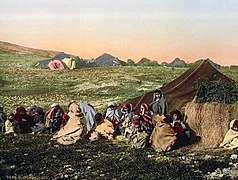 Photograph of Bedouins (wandering Arabs) of Tunisia, 1899
Photograph of Bedouins (wandering Arabs) of Tunisia, 1899 Indian nomads painting by well-known artiste Raja Ravi Varma
Indian nomads painting by well-known artiste Raja Ravi Varma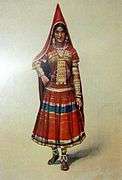 Indian nomad Banjara
Indian nomad Banjara
See also
- List of nomadic peoples
- Eurasian nomads
- Nomadic peoples of Europe
- Seasonal human migration
- Nomadic empires
- Nomadic tents
- Nomads of India
- Sea Gypsies
- Antlers Gallery: The 'nomadic' gallery, Bristol
- Snufkin
Figurative use of the term:
- Global nomad
- Digital nomad
- Snowbird (people)
- Military brat
- The Nomadic Project
- Perpetual traveler
- RV lifestyle
- Third culture kid
References
- English dictionaries agree that the word came from French in the 16th century but incorrectly claim that the French word referred to pasturing. (See the American Heritage Dictionary and the Digitized Treasury of the French Language (in French). The meanings of the Latin and Greek predecessors are irrelevant and in fact misleading for the meaning of the English word.)
- Columbia Electronic Encyclopedia
- Encyclopaedia Britannica
- Annamoradnejad, Rahimberdi; Lotfi, Sedigheh (2010). "Demographic changes of nomadic communities in Iran (1956–2008)". Asian Population Studies. 6 (3): 335–45. doi:10.1080/17441730.2010.512764.
- "Nomads: At the Crossroads – The Facts". New Internationalist (266). April 5, 1995.
- "Subsistence". explorable.com. Retrieved 2019-02-24.
- Homewood, Katherine; Rodgers, W.A. (1988-01-21), "Pastoralism, conservation and the overgrazing controversy", Conservation in Africa, Cambridge University Press, pp. 111–128, ISBN 978-0-521-34199-8, retrieved 2020-05-27
- Teichmann, Michael. "ROMBASE: Didactically edited information on Roma" (PDF). Archived from the original (PDF) on 2014-04-21. Retrieved 2014-04-20.
- Rao, Aparna (1987). The concept of peripatetics: An introduction. Cologne: Bohlau Verlag. pp. 1–32.
[...] peripatetics, [...] endogamous nomads who are largely non-primary producers or extractors, and whose principal resources are constituted by other human populations [...].
-
Adorno, Theodor W. (1951). "Princess Lizard" [Prinzessin Eidechse]. Minima Moralia: Reflections from Damaged Life. Translated by Jephcott, E. F. N. London: Verso (published 1978). p. 170. ISBN 9780860917045. Retrieved 12 June 2019.
The sedentary man envies the nomadic existence, the quest for green pastures, and the painted waggon is the house on wheels whose course follows the stars.
- "Your pictures: Ed Vallance". BBC News – In Pictures. 2008-09-23. Retrieved 29 April 2015.
- Yee, Danny (1991). "The Development of Nomadism in Ancient Northeast Africa Karim Sadr [Book Review]".
- Nomads of the Middle East Archived 2009-04-28 at the Wayback Machine, David Zeidan, OM-IRC, 1995
- Ning, Shi; Dupont, Lydie M. (June 1997). "Vegetation and climatic history of southwest Africa: A marine palynological record of the last 300,000 years". Vegetation History and Archaeobotany. 6 (2): 117–131. doi:10.1007/bf01261959. ISSN 0939-6314.
- Patterns of Subsistence: Pastoralism
-
Fouché, Leo (1936). "V: Foundation of the Cape Colony, 1652–1708". In Walker, Eric Anderson (ed.). The Cambridge History of the British Empire. VIII: South Africa, Rhodesia and the Protectorates. Cambridge: CUP Archive (published 1963). p. 136. Retrieved 2016-11-16.
[...] van der Stel recognised the roving tendency among the colonists and tried to arrest it. A proclamation of 1692 illustrated his fears: it stated that colonists were making a living by grazing cattle and bartering in the interior [...]. This seems clear proof that the trekboer, as a distinct type, was coming into existence during the time of van der Stel. [...] Generation after generation of these hardy and self-reliant nomads pushed the frontiers of civilisation further into the wilderness.
- Pastoral Livestock Development in Central Asia, FAO Rural Development Division
- "CONCLUSION:", Speaking Soviet with an Accent, University of Pittsburgh Press, pp. 140–146, ISBN 978-0-8229-7809-1, retrieved 2020-05-27
- "Persian & Iranian Nomads at Best Iran Travel.com". Retrieved 29 April 2015.
- Moussavi-Nejad, Ebrahim (December 2003). "Censuses of Pastoral Nomads and Some General Remarks about the Census of Nomadic Tribes of Iran in 1998". Nomadic Peoples. 7 (2): 24–35. doi:10.3167/082279403781826328. Retrieved 29 April 2015 – via Online Research Library: Questia.
- Iran's nomads going extinct, Los Angeles Times, February 18, 2008
- "National Geographic: Images of Animals, Nature, and Cultures". Archived from the original on 18 May 2009. Retrieved 29 April 2015.
- "Kazahstan Student Society in the United Kingdom". Retrieved 29 April 2015.
- "General information". Retrieved 29 April 2015.
- The Middle East People Groups and Their Distribution Archived 2009-01-26 at the Wayback Machine, Zeidan, David, OM-IRC, 1995
- Mauritania – Political Power in the Mid-1980s, U.S. Library of Congress Country Studies
- "Severe Drought Driving Nomads From Desert", Los Angeles Times, June 30, 2000
- Niger way of life 'under threat', BBC News, August 16, 2005
- Mali's nomads face famine BBC News, August 9, 2005
- Goldstein, Mervyll (1990). Nomads of Western Tibet: The Survival of a Way of Life. University of California Press. p. 114.
- Pavlovic, Zoran (2003). Kazakhstan. Infobase Publishing. p. 57. ISBN 978-1438105192.
- Gmelch, S B (October 1986). "Groups That Don't Want In: Gypsies and Other Artisan, Trader, and Entertainer Minorities". Annual Review of Anthropology. 15 (1): 307–330. doi:10.1146/annurev.an.15.100186.001515. ISSN 0084-6570.
- Peripatetics of Afghanistan, Iran, and Turkey
- Berland, Joseph C.; Rao, Aparna (2004). Customary Strangers. ISBN 978-0897897716. Retrieved 29 April 2015.
Further reading
| Wikimedia Commons has media related to Nomads. |
| Wikisource has the text of the 1905 New International Encyclopedia article Nomad. |
- Oberfalzerova, Alena (2006): Metaphors and Nomads, Triton, Prague. ISBN 80-7254-849-2
- Sadr, Karim (1991). The Development of Nomadism in Ancient Northeast Africa, University of Pennsylvania Press. ISBN 0-8122-3066-3
- Cowan, Gregory (2002). "Nomadology in Architecture: Ephemerality, Movement and Collaboration" University of Adelaide (available: http://hdl.handle.net/2440/37830 )
- Chatty, Dawn (1983–2009). Articles on Nomadic life
- Chatwin, Bruce (1987). The Songlines
- Deleuze and Guattari (1980). A Thousand Plateaus
- Melvyn Goldstein: The Impact of China's Reform Policy on the Nomads of Western Tibet
- The Remote World of Tibet's Nomads
- Grousset, René (1939). L'Empire des Steppes (in French)
- Michael Haerdter. Remarks on modernity, mobility, nomadism and the arts
- Kradin, Nikolay (2004). "Nomadic Empires in Evolutionary Perspective". In Alternatives of Social Evolution. Ed. by N.N. Kradin, A.V. Korotayev, Dmitri Bondarenko, V. de Munck, and P.K. Wason (pp. 274–88). Vladivostok: Far Eastern Branch of the Russian Academy of Sciences; reprinted in: The Early State, its Alternatives and Analogues. Ed. by Leonid Grinin et al. (pр. 501–24). Volgograd: Uchitel'.
- Kradin, Nikolay N. (2002). "Nomadism, Evolution, and World-Systems: Pastoral Societies in Theories of Historical Development+. Journal of World-System Research 8: 368–88.
- Kradin, Nikolay N. (2003). "Nomadic Empires: Origins, Rise, Declin"e. In Nomadic Pathways in Social Evolution. Ed. by N.N. Kradin, Dmitri Bondarenko, and T. Barfield (pp. 73–87). Moscow: Center for Civilizational Studies, Russian Academy of Sciences.
- Kradin, Nikolay N. (2006). "Cultural Complexity of Pastoral Nomads". World Cultures 15: 171–89.
- Beall, Cynthia and Goldstein, Melvyn (May 1993). "Past becoming future for Mongolian nomads" National Geographic Magazine
- Vigo, Julian (2005). "Nomadic Sexualities and Nationalities: Postcolonial Performative Words and Visual Texts". Inscriptions in the Sand Famagusta: Eastern Mediterranean University Press.


